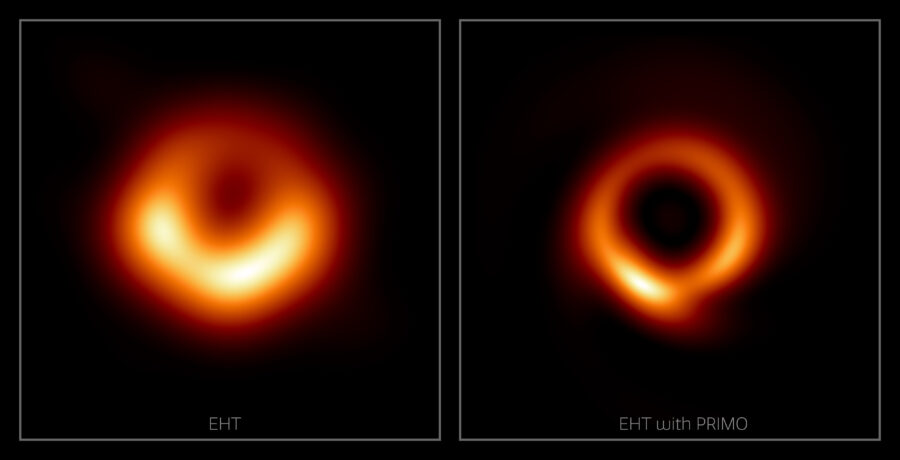A new analysis of Event Horizon Telescope data sharpens our view of the glowing gas encircling the black hole.

L. Medeiros (Institute for Advanced Study), D. Psaltis (Georgia Tech), T. Lauer (NSF / NOIRLab), and F. Ozel (Georgia Tech)
These two images might look like different things: one a fat, blurry orange doughnut, the other the sinuous noose on the end of a lariat. But they’re two views of the same black hole. This black hole, the leviathan dwelling in the heart of the elliptical galaxy M87, rocketed to worldwide fame in 2019 when the Event Horizon Telescope collaboration released their hard-won image of the black hole’s silhouette. (That’s the image on the left.)
Astronomers have now changed the lenses on the computational glasses they use to reconstruct the image, creating the view on the right.
The EHT can’t merely take a picture of a black hole. The silhouette is about 40 microarcseconds wide, the size of a hydrogen atom seen at arm’s length. To resolve that, you need a planet-size radio telescope — which doesn’t exist. So instead, scientists piece together data taken at different observatories spread across the globe, carefully reconstructing the shadow from sparse information using complex computer algorithms. It’s as though you were given the height, ear size, and skin texture of an elephant and then had to figure out exactly what the creature looks like.
To make an image from such piecemeal details, algorithms have to fill in the missing data. That can and should make us squeamish: We need to know that the assumptions behind algorithms’ infilling aren’t leading us astray. For the original image, scientists used algorithms that made no assumptions about what the EHT was looking at, to avoid telling themselves a shadow ringed by hot, glowing gas was there when it actually wasn’t. This approach, coupled with the way they blurred the deduced image to show only features they were sure were real, left them with a wide, fuzzy ring with few discernable details.
Lia Medeiros (Institute for Advanced Study and University of Arizona) and three other EHT astronomers have now tried something different. They’ve developed a new algorithm, called principal-component interferometric modeling (PRIMO). PRIMO doesn’t start from the same level of agnosticism: Now that we’ve confirmed we’re dealing with a ring around a black hole, the team says, we can narrow the options.
The researchers trained PRIMO to recognize the details of what accreting black holes look like, using a library of 30,000 simulated images. These images span many kinds of conditions, including some that probably don’t match M87* (M87’s black hole, pronounced “Em-eighty-seven-star”). PRIMO “learned” what the common structures are and how the simulated data would look to an array like the EHT. Then it compared the result to the EHT observations to tease out a ring from the data.
The new image is sharper than the old one, showing a ring about half as wide as before. (Astronomers know the real ring is very thin, even thinner than what’s shown here.) It’s still blurry, fuzzified to match the EHT’s resolution. But the team blurred the image in a new way, suppressing the glow from scales at which we have no data, instead of the more general blurring done in the original analysis.
Because of this new blurring method and because PRIMO’s assumptions are solely motivated by what we expect to happen physically, PRIMO avoids traditional algorithms’ limitations and can reconstruct an image that reaches the array’s nominal resolution, the team argues in the April 10th Astrophysical Journal Letters.
This image, however, does not replace the original. Given that PRIMO bakes in assumptions about what the EHT is looking at, not everyone will be comfortable trusting what pops out of the computational oven. Is it telling us what’s really there, or only what we think should be there — or some mishmash of both? The full collaboration still needs to suss out the answer.
The collaboration has more EHT observations to digest, and approaches like PRIMO might or might not eventually be part of the recipe used to reconstruct future images. Better shadow images will tell us more about black holes, including enabling us to better infer the objects’ masses. That’s work for the future; Medeiros’s team hasn’t redone those calculations yet using PRIMO. It will be interesting to see whether astronomers revise the 2019 mass estimate for M87* — about 6.5 billion Suns — to bring it closer to a new estimate by Emily Liepold (University of California, Berkeley) and others, which puts the mass around 5.4 billion Suns.
Reference:
L. Medeiros et al. “The Image of the M87 Black Hole Reconstructed with PRIMO.” Astrophysical Journal Letters. April 10, 2023.
 2
2









Comments
tom-dasilva
April 18, 2023 at 12:49 pm
how long did the data capture take vs. the angular rate of the ring material? Simple question not answered yet. Also, does the ring reside at the boundary of stable orbit? I presume so. Where in the picture is the event horizon? Would be interesting to see a scale in AU attached to the images.
You must be logged in to post a comment.
Tod R. Lauer
April 18, 2023 at 6:11 pm
The data were taken on an interval short compared to the orbital period of gas around the BH. The ring corresponds to the size of the photon shadow, which marks the scale on which photons with orbit the hole. This is about 50% larger than the event horizon. The event horizon is thus interior to the ring.
You must be logged in to post a comment.
You must be logged in to post a comment.